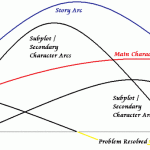
A writing adage warns writers not to burn down the tree in the first chapter. Think of this as a plea to save writing your story’s jaw-drop moments for the best spot in the story timeline.
Writing Tip for Today: Here are some ideas for building tension by saving those high-stakes moments:
Tell Yourself the Story
We’ve all told others our most dramatic stories. The time you nearly drove your car off a cliff. When you nearly forgot which twin was which. The moment you had to break up a midnight fight between your sons. All of these moments are dramatic. And yes, they happened to me. But where should they be on the story’s timeline?
If you lead off your story with one of these jaw-drop dramatic moments, how will you top that? A tree that burns will start with a spark that grows in intensity. If the tree just explodes, readers will likely feel let down. If they experience such a heart-pounding event in your story’s beginning, only to read less dramatic events afterward, the tree is a cinder too soon.
As you write, remember the way you might relate your story orally. If you sit around the campfire, you likely will save the highest action/emotion/event for the climax of the story. Writers often attempt to grab readers’ attention by leading with a dramatic moment. But if you can’t raise the tension for every scene which follows, your story will suffer. Remember to ignite the tree first, then build the flames branch by branch.
Withholding
One way to both grab opening attention and save the highest drama (tree burning) for near the story’s end is to withhold vital information. Withholding information crucial to understanding the event helps to foster tension. Readers can keep wondering how the pieces of the event fit together. If you build the tree burning branch by branch but omit the forest fire raging, readers won’t see the wildfire for the tree. (sorry!)
Many stories use this technique to both satisfy and surprise the reader. A twist such as the character learning at last where he/she belongs can build tension throughout the story by withholding certain bits of needed info. For example, in my above example of forgetting which twin is which, I never tell readers that the twins are boy/girl fraternal until the very last moment.
Be careful with this withholding technique. You don’t really want to withhold too much of your character’s emotions as he/she battles through different conflicts on the way to getting what he/she wants. The best stories let emotions, attitudes and actions build into what’s known as rising action. The pieces you choose to withhold must be keys which unlock a mystery. Rising action (drama that gets more intense with each scene) helps keep readers reading.

Rising Action keeps readers reading.
Foreshadows and Plants
Foreshadowing gives hints early in the story but leaves out the climax and resolution. If the conflict is the high point (biggest obstacle) your POV character faces in pursuit of the goal, build that tension slowly. Think of it as stacking tension, with each new scene a little higher in drama than the one before it.
Planting hints or brief introductions early in the story will help readers get a sense of what is at stake and intuit the eventual climax. For instance, let’s say your character has a conflict with another character, but that second character doesn’t come on scene until a scene well-past the midpoint.
By letting the second character briefly come on scene earlier in the story, readers will already be familiar and can logically follow the ensuing conflict. By foreshadowing and planting the hint of the big climax in the story’s beginning, you can set up a logical, satisfying and dramatic climax. When that tree finally incinerates, readers will be ready.




